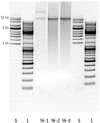Probiotic Bacillus cereus Strains, a Potential Risk for Public Health in China
- PMID: 27242738
- PMCID: PMC4876114
- DOI: 10.3389/fmicb.2016.00718
Probiotic Bacillus cereus Strains, a Potential Risk for Public Health in China
Abstract
Bacillus cereus is an important cause of foodborne infectious disease and food poisoning. However, B. cereus has also been used as a probiotic in human medicine and livestock production, with low standards of safety assessment. In this study, we evaluated the safety of 15 commercial probiotic B. cereus preparations from China in terms of mislabeling, toxin production, and transferable antimicrobial resistance. Most preparations were incorrectly labeled, as they contained additional bacterial species; one product did not contain viable B. cereus at all. In total, 18 B. cereus group strains-specifically B. cereus and Bacillus thuringiensis-were isolated. Enterotoxin genes nhe, hbl, and cytK1, as well as the ces-gene were assessed by PCR. Enterotoxin production and cytotoxicity were confirmed by ELISA and cell culture assays, respectively. All isolated B. cereus group strains produced the enterotoxin Nhe; 15 strains additionally produced Hbl. Antimicrobial resistance was assessed by microdilution; resistance genes were detected by PCR and further characterized by sequencing, transformation and conjugation assays. Nearly half of the strains harbored the antimicrobial resistance gene tet(45). In one strain, tet(45) was situated on a mobile genetic element-encoding a site-specific recombination mechanism-and was transferable to Staphylococcus aureus and Bacillus subtilis by electro-transformation. In view of the wide and uncontrolled use of these products, stricter regulations for safety assessment, including determination of virulence factors and transferable antimicrobial resistance genes, are urgently needed.
Keywords: Bacillus cereus; China; antimicrobial resistance; dif site; enterotoxin; probiotic; site-specific recombination; tetracycline resistance gene tet(45).
Figures



Similar articles
-
Antimicrobial resistance, virulence characteristics and genotypes of Bacillus spp. from probiotic products of diverse origins.Food Res Int. 2021 Jan;139:109949. doi: 10.1016/j.foodres.2020.109949. Epub 2020 Dec 7. Food Res Int. 2021. PMID: 33509502
-
Characterization of Bacillus cereus isolates from local dairy farms in China.FEMS Microbiol Lett. 2016 Jun;363(12):fnw096. doi: 10.1093/femsle/fnw096. Epub 2016 Apr 27. FEMS Microbiol Lett. 2016. PMID: 27190168
-
Massive horizontal gene transfer, strictly vertical inheritance and ancient duplications differentially shape the evolution of Bacillus cereus enterotoxin operons hbl, cytK and nhe.BMC Evol Biol. 2015 Nov 10;15:246. doi: 10.1186/s12862-015-0529-4. BMC Evol Biol. 2015. PMID: 26555390 Free PMC article.
-
Multifaceted toxin profile, an approach toward a better understanding of probiotic Bacillus cereus.Crit Rev Toxicol. 2019 Apr;49(4):342-356. doi: 10.1080/10408444.2019.1609410. Epub 2019 May 22. Crit Rev Toxicol. 2019. PMID: 31116061 Review.
-
Bacillus strains as human probiotics: characterization, safety, microbiome, and probiotic carrier.Food Sci Biotechnol. 2019 Oct 8;28(5):1297-1305. doi: 10.1007/s10068-019-00691-9. eCollection 2019 Oct. Food Sci Biotechnol. 2019. PMID: 31695928 Free PMC article. Review.
Cited by
-
A virulent Bacillus cereus strain from deep-sea cold seep induces pyroptosis in a manner that involves NLRP3 inflammasome, JNK pathway, and lysosomal rupture.Virulence. 2021 Dec;12(1):1362-1376. doi: 10.1080/21505594.2021.1926649. Virulence. 2021. PMID: 34009097 Free PMC article.
-
Pathological changes of highly pathogenic Bacillus cereus on Pelodiscus sinensis.Vet Q. 2023 Dec;43(1):1-10. doi: 10.1080/01652176.2023.2287191. Epub 2023 Dec 1. Vet Q. 2023. PMID: 38010068 Free PMC article.
-
Conjugation across Bacillus cereus and kin: A review.Front Microbiol. 2022 Nov 4;13:1034440. doi: 10.3389/fmicb.2022.1034440. eCollection 2022. Front Microbiol. 2022. PMID: 36406448 Free PMC article. Review.
-
The genomic characterisation and comparison of Bacillus cereus strains isolated from indoor air.Gut Pathog. 2021 Jan 30;13(1):6. doi: 10.1186/s13099-021-00399-4. Gut Pathog. 2021. PMID: 33516253 Free PMC article.
-
Biological Characterization and Whole-Genome Analysis of Bacillus subtilis MG-1 Isolated from Mink Fecal Samples.Microorganisms. 2023 Nov 21;11(12):2821. doi: 10.3390/microorganisms11122821. Microorganisms. 2023. PMID: 38137965 Free PMC article.
References
LinkOut - more resources
Full Text Sources
Other Literature Sources
Research Materials

